Human Resource Strategies for Business Strategy Implementation
VerifiedAdded on 2020/05/28
|5
|1099
|193
Report
AI Summary
This report provides an in-depth analysis of crucial human resource strategies essential for the successful implementation of a business strategy. Focusing on Mercia Systems Ltd, the report emphasizes the alignment of HR practices with the company's long-term and short-term business objectives. Key strategies include the development of problem-solving teams composed of diverse professionals, continuous improvement in marketing efforts to drive sales and customer engagement, attracting and retaining highly skilled staff, and ensuring continuous performance improvement through motivation and benchmarking against industry peers. The report highlights the importance of a solution-oriented approach and the effective utilization of technology to maintain a competitive market position and deliver value to customers. The report is comprehensive, referencing multiple sources to support the claims and provide a well-rounded perspective on human resource management.
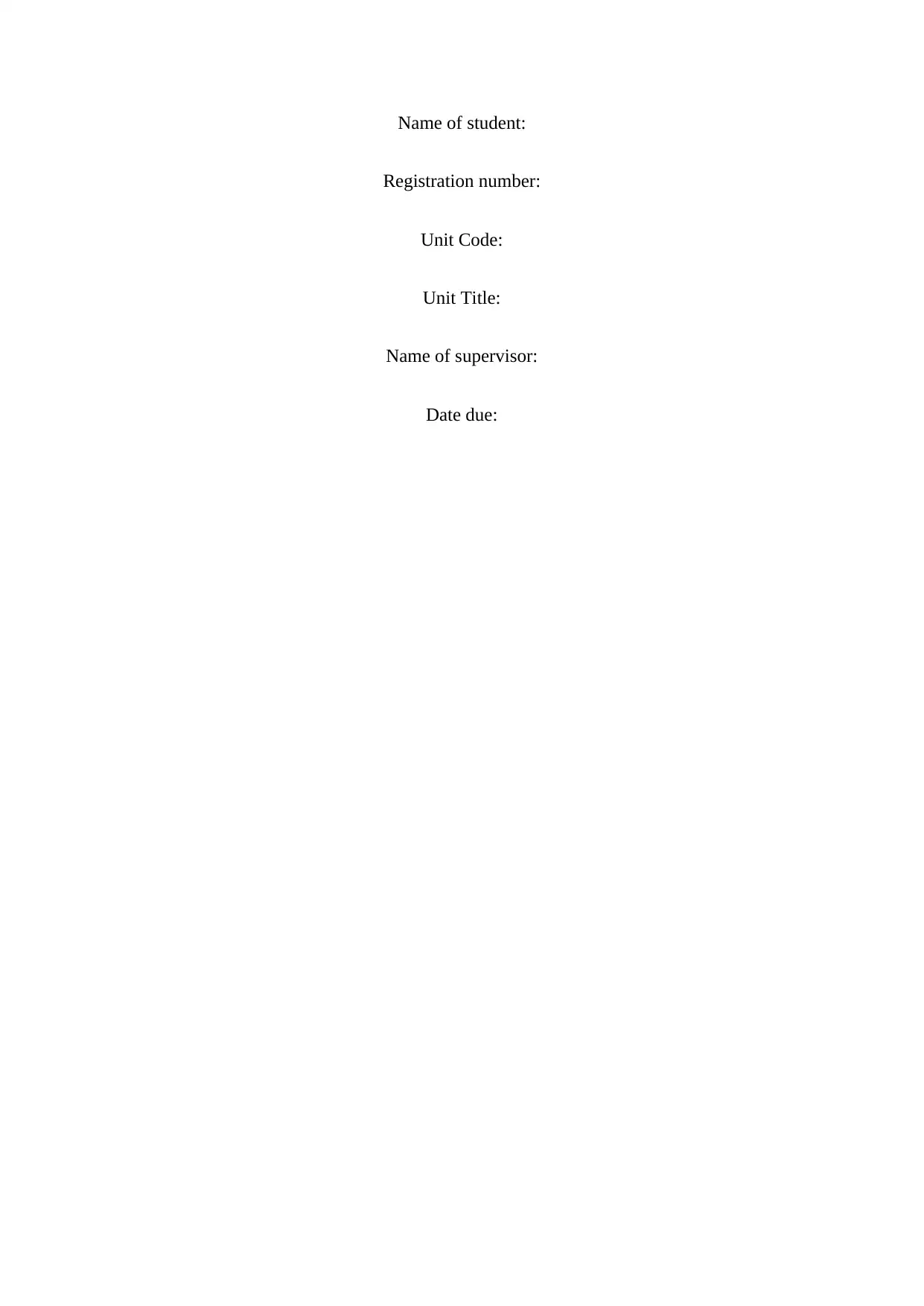
Name of student:
Registration number:
Unit Code:
Unit Title:
Name of supervisor:
Date due:
Registration number:
Unit Code:
Unit Title:
Name of supervisor:
Date due:
Paraphrase This Document
Need a fresh take? Get an instant paraphrase of this document with our AI Paraphraser
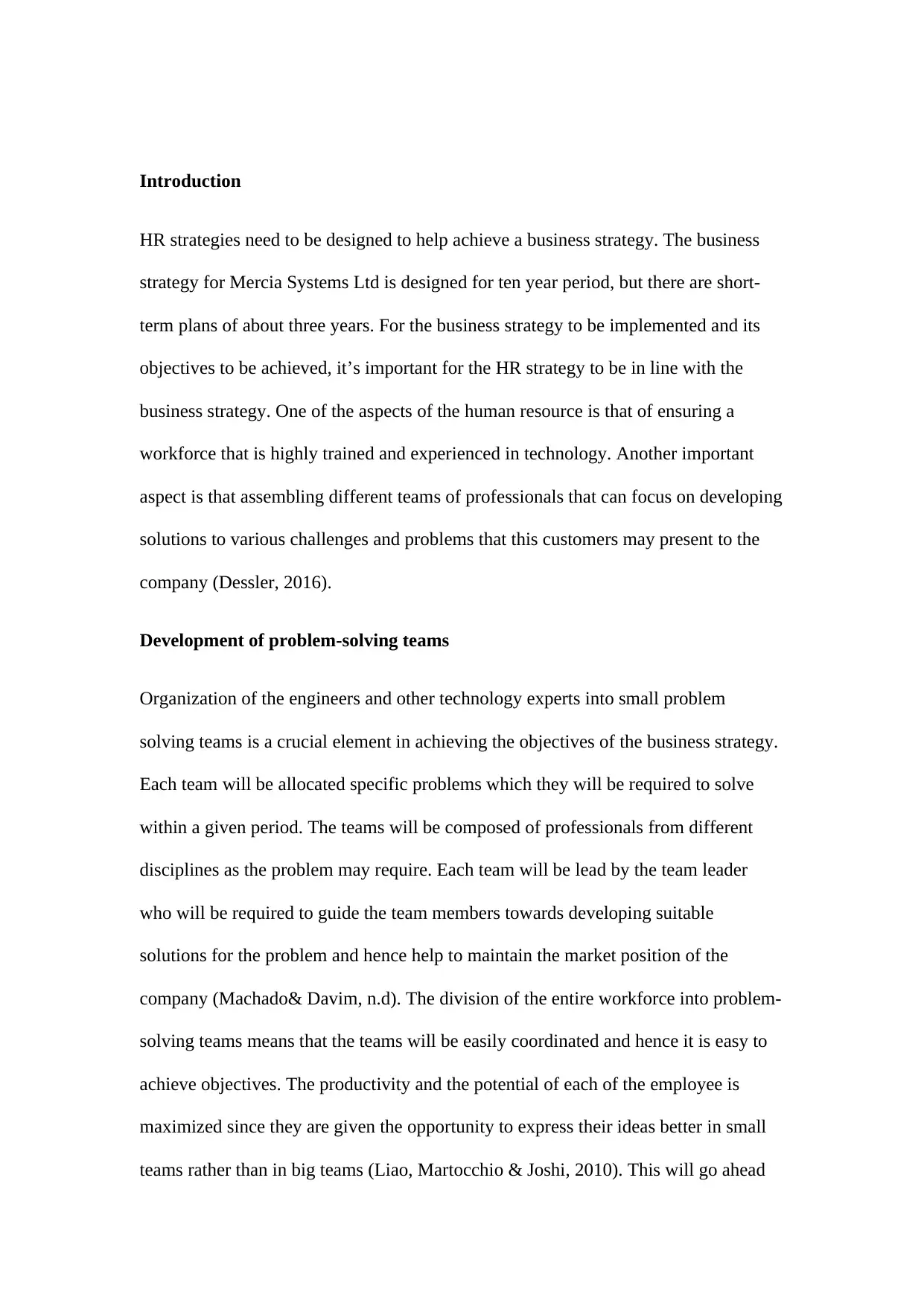
Introduction
HR strategies need to be designed to help achieve a business strategy. The business
strategy for Mercia Systems Ltd is designed for ten year period, but there are short-
term plans of about three years. For the business strategy to be implemented and its
objectives to be achieved, it’s important for the HR strategy to be in line with the
business strategy. One of the aspects of the human resource is that of ensuring a
workforce that is highly trained and experienced in technology. Another important
aspect is that assembling different teams of professionals that can focus on developing
solutions to various challenges and problems that this customers may present to the
company (Dessler, 2016).
Development of problem-solving teams
Organization of the engineers and other technology experts into small problem
solving teams is a crucial element in achieving the objectives of the business strategy.
Each team will be allocated specific problems which they will be required to solve
within a given period. The teams will be composed of professionals from different
disciplines as the problem may require. Each team will be lead by the team leader
who will be required to guide the team members towards developing suitable
solutions for the problem and hence help to maintain the market position of the
company (Machado& Davim, n.d). The division of the entire workforce into problem-
solving teams means that the teams will be easily coordinated and hence it is easy to
achieve objectives. The productivity and the potential of each of the employee is
maximized since they are given the opportunity to express their ideas better in small
teams rather than in big teams (Liao, Martocchio & Joshi, 2010). This will go ahead
HR strategies need to be designed to help achieve a business strategy. The business
strategy for Mercia Systems Ltd is designed for ten year period, but there are short-
term plans of about three years. For the business strategy to be implemented and its
objectives to be achieved, it’s important for the HR strategy to be in line with the
business strategy. One of the aspects of the human resource is that of ensuring a
workforce that is highly trained and experienced in technology. Another important
aspect is that assembling different teams of professionals that can focus on developing
solutions to various challenges and problems that this customers may present to the
company (Dessler, 2016).
Development of problem-solving teams
Organization of the engineers and other technology experts into small problem
solving teams is a crucial element in achieving the objectives of the business strategy.
Each team will be allocated specific problems which they will be required to solve
within a given period. The teams will be composed of professionals from different
disciplines as the problem may require. Each team will be lead by the team leader
who will be required to guide the team members towards developing suitable
solutions for the problem and hence help to maintain the market position of the
company (Machado& Davim, n.d). The division of the entire workforce into problem-
solving teams means that the teams will be easily coordinated and hence it is easy to
achieve objectives. The productivity and the potential of each of the employee is
maximized since they are given the opportunity to express their ideas better in small
teams rather than in big teams (Liao, Martocchio & Joshi, 2010). This will go ahead
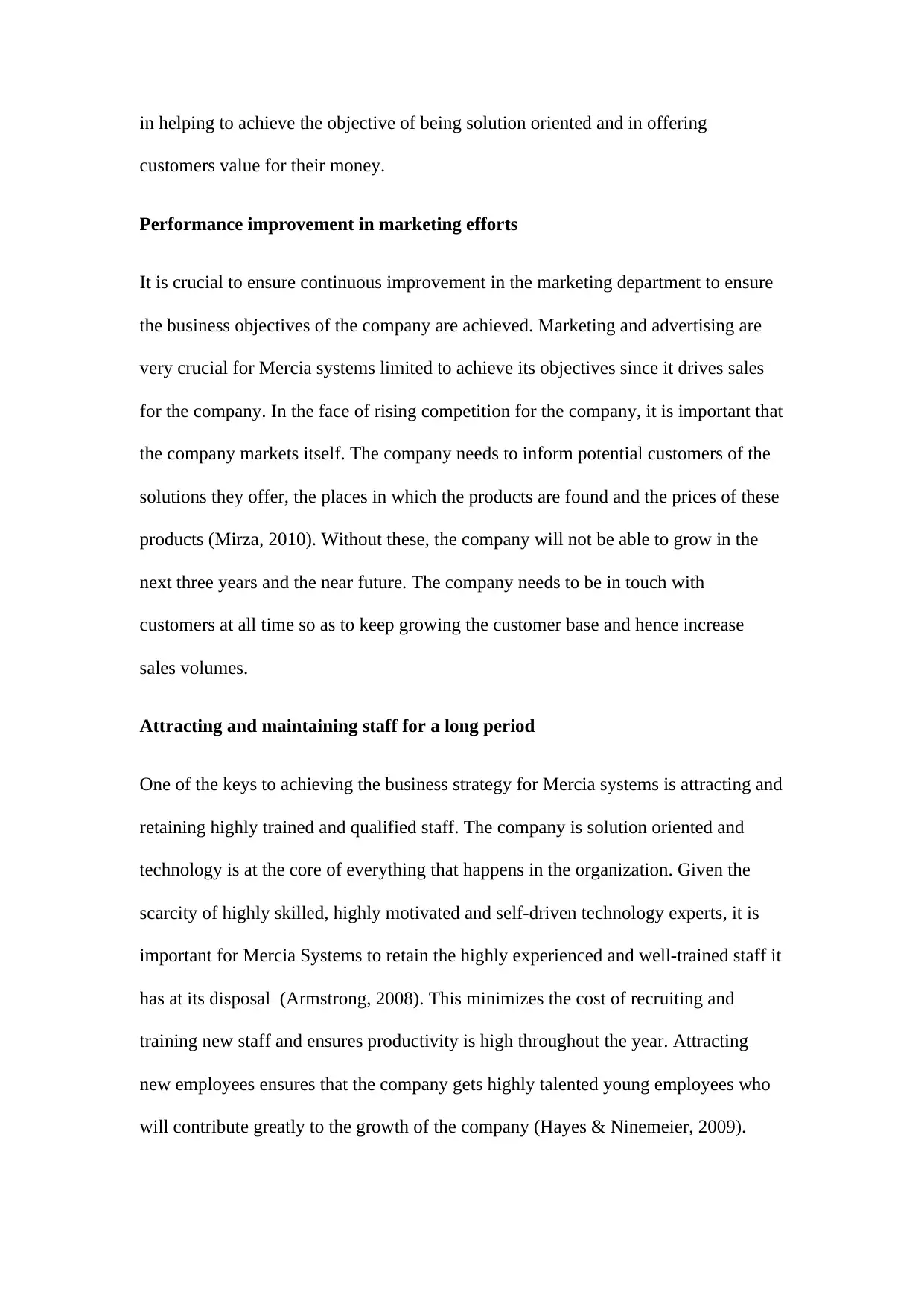
in helping to achieve the objective of being solution oriented and in offering
customers value for their money.
Performance improvement in marketing efforts
It is crucial to ensure continuous improvement in the marketing department to ensure
the business objectives of the company are achieved. Marketing and advertising are
very crucial for Mercia systems limited to achieve its objectives since it drives sales
for the company. In the face of rising competition for the company, it is important that
the company markets itself. The company needs to inform potential customers of the
solutions they offer, the places in which the products are found and the prices of these
products (Mirza, 2010). Without these, the company will not be able to grow in the
next three years and the near future. The company needs to be in touch with
customers at all time so as to keep growing the customer base and hence increase
sales volumes.
Attracting and maintaining staff for a long period
One of the keys to achieving the business strategy for Mercia systems is attracting and
retaining highly trained and qualified staff. The company is solution oriented and
technology is at the core of everything that happens in the organization. Given the
scarcity of highly skilled, highly motivated and self-driven technology experts, it is
important for Mercia Systems to retain the highly experienced and well-trained staff it
has at its disposal (Armstrong, 2008). This minimizes the cost of recruiting and
training new staff and ensures productivity is high throughout the year. Attracting
new employees ensures that the company gets highly talented young employees who
will contribute greatly to the growth of the company (Hayes & Ninemeier, 2009).
customers value for their money.
Performance improvement in marketing efforts
It is crucial to ensure continuous improvement in the marketing department to ensure
the business objectives of the company are achieved. Marketing and advertising are
very crucial for Mercia systems limited to achieve its objectives since it drives sales
for the company. In the face of rising competition for the company, it is important that
the company markets itself. The company needs to inform potential customers of the
solutions they offer, the places in which the products are found and the prices of these
products (Mirza, 2010). Without these, the company will not be able to grow in the
next three years and the near future. The company needs to be in touch with
customers at all time so as to keep growing the customer base and hence increase
sales volumes.
Attracting and maintaining staff for a long period
One of the keys to achieving the business strategy for Mercia systems is attracting and
retaining highly trained and qualified staff. The company is solution oriented and
technology is at the core of everything that happens in the organization. Given the
scarcity of highly skilled, highly motivated and self-driven technology experts, it is
important for Mercia Systems to retain the highly experienced and well-trained staff it
has at its disposal (Armstrong, 2008). This minimizes the cost of recruiting and
training new staff and ensures productivity is high throughout the year. Attracting
new employees ensures that the company gets highly talented young employees who
will contribute greatly to the growth of the company (Hayes & Ninemeier, 2009).
⊘ This is a preview!⊘
Do you want full access?
Subscribe today to unlock all pages.

Trusted by 1+ million students worldwide
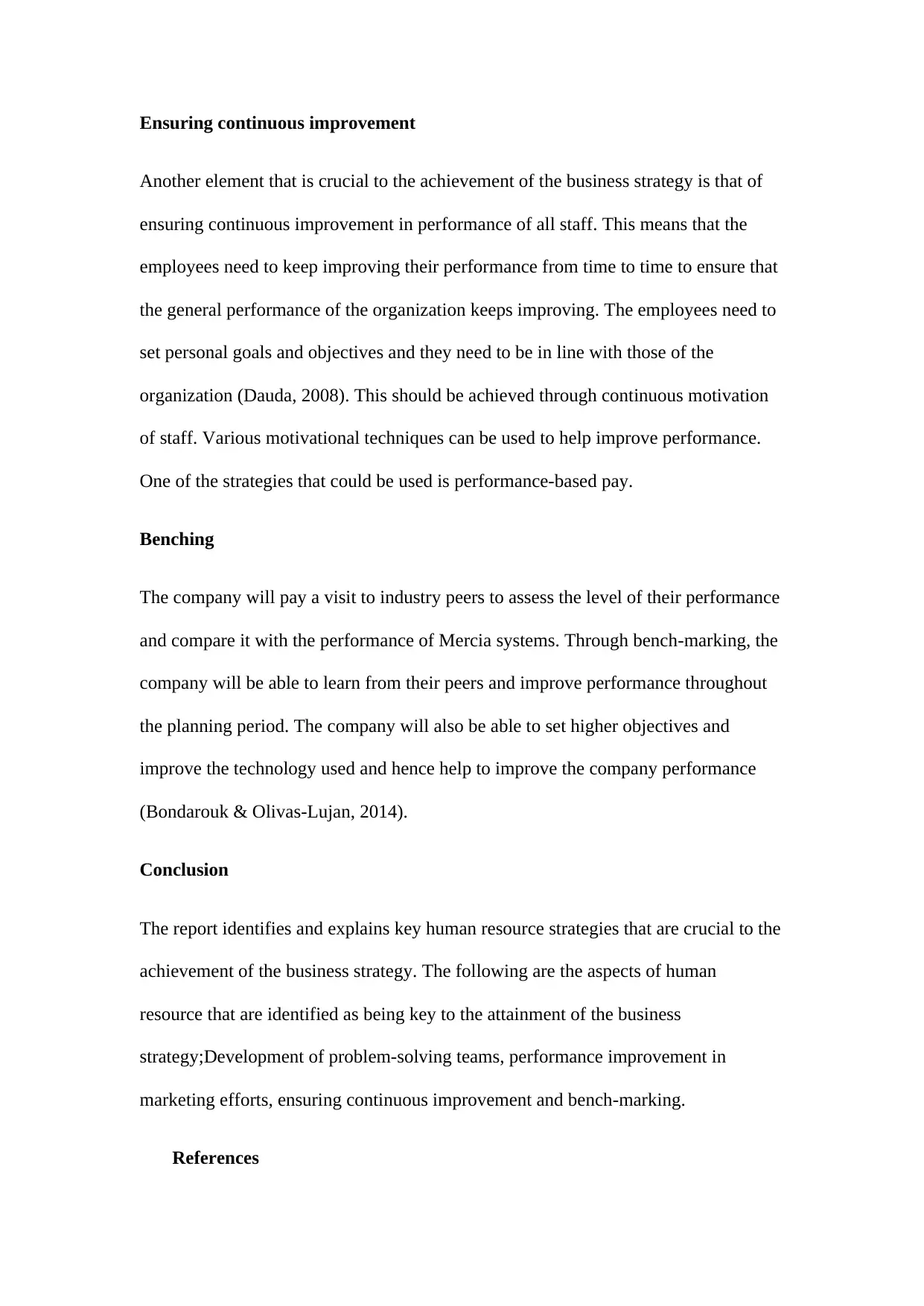
Ensuring continuous improvement
Another element that is crucial to the achievement of the business strategy is that of
ensuring continuous improvement in performance of all staff. This means that the
employees need to keep improving their performance from time to time to ensure that
the general performance of the organization keeps improving. The employees need to
set personal goals and objectives and they need to be in line with those of the
organization (Dauda, 2008). This should be achieved through continuous motivation
of staff. Various motivational techniques can be used to help improve performance.
One of the strategies that could be used is performance-based pay.
Benching
The company will pay a visit to industry peers to assess the level of their performance
and compare it with the performance of Mercia systems. Through bench-marking, the
company will be able to learn from their peers and improve performance throughout
the planning period. The company will also be able to set higher objectives and
improve the technology used and hence help to improve the company performance
(Bondarouk & Olivas-Lujan, 2014).
Conclusion
The report identifies and explains key human resource strategies that are crucial to the
achievement of the business strategy. The following are the aspects of human
resource that are identified as being key to the attainment of the business
strategy;Development of problem-solving teams, performance improvement in
marketing efforts, ensuring continuous improvement and bench-marking.
References
Another element that is crucial to the achievement of the business strategy is that of
ensuring continuous improvement in performance of all staff. This means that the
employees need to keep improving their performance from time to time to ensure that
the general performance of the organization keeps improving. The employees need to
set personal goals and objectives and they need to be in line with those of the
organization (Dauda, 2008). This should be achieved through continuous motivation
of staff. Various motivational techniques can be used to help improve performance.
One of the strategies that could be used is performance-based pay.
Benching
The company will pay a visit to industry peers to assess the level of their performance
and compare it with the performance of Mercia systems. Through bench-marking, the
company will be able to learn from their peers and improve performance throughout
the planning period. The company will also be able to set higher objectives and
improve the technology used and hence help to improve the company performance
(Bondarouk & Olivas-Lujan, 2014).
Conclusion
The report identifies and explains key human resource strategies that are crucial to the
achievement of the business strategy. The following are the aspects of human
resource that are identified as being key to the attainment of the business
strategy;Development of problem-solving teams, performance improvement in
marketing efforts, ensuring continuous improvement and bench-marking.
References
Paraphrase This Document
Need a fresh take? Get an instant paraphrase of this document with our AI Paraphraser
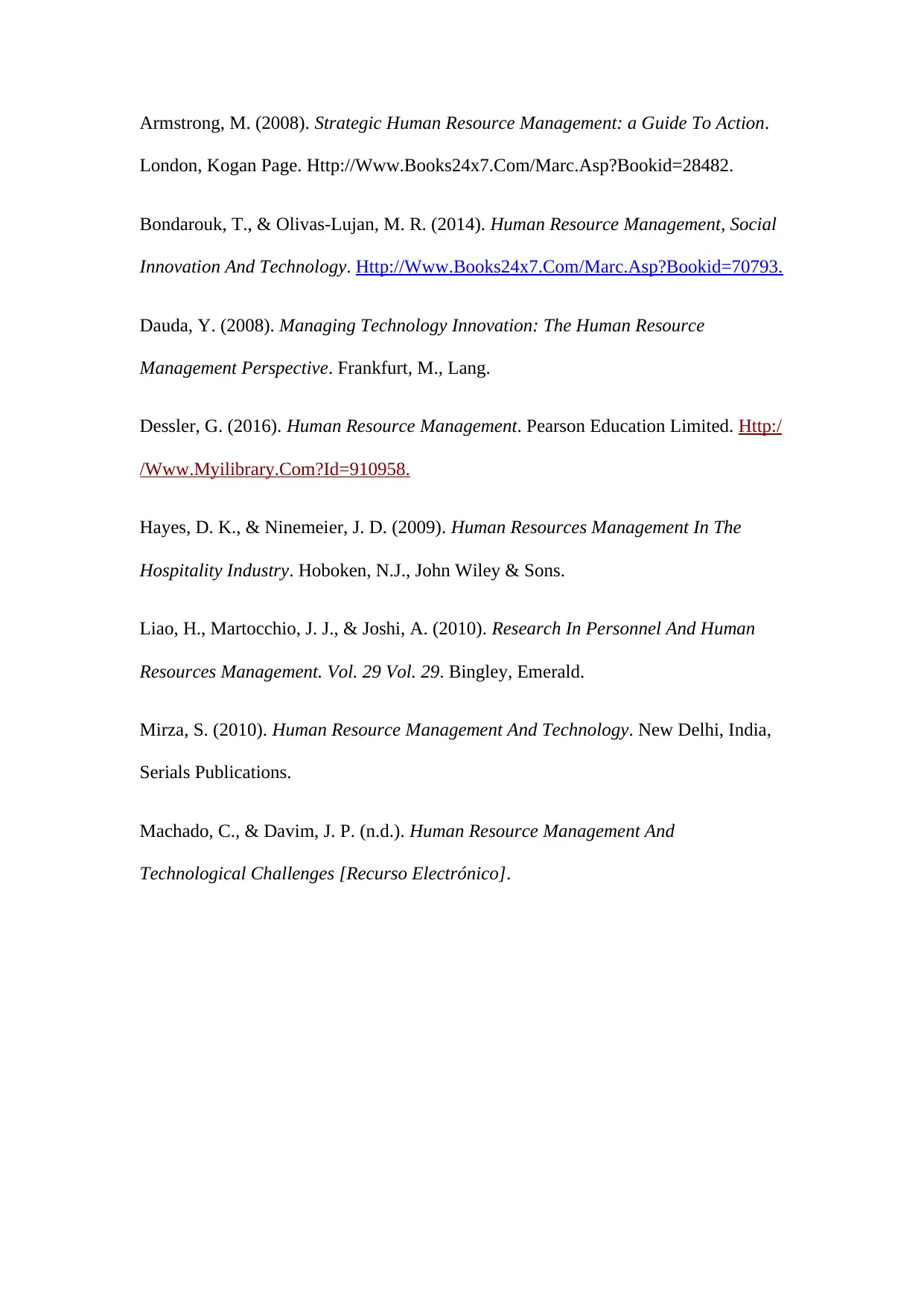
Armstrong, M. (2008). Strategic Human Resource Management: a Guide To Action.
London, Kogan Page. Http://Www.Books24x7.Com/Marc.Asp?Bookid=28482.
Bondarouk, T., & Olivas-Lujan, M. R. (2014). Human Resource Management, Social
Innovation And Technology. Http://Www.Books24x7.Com/Marc.Asp?Bookid=70793.
Dauda, Y. (2008). Managing Technology Innovation: The Human Resource
Management Perspective. Frankfurt, M., Lang.
Dessler, G. (2016). Human Resource Management. Pearson Education Limited. Http:/
/Www.Myilibrary.Com?Id=910958.
Hayes, D. K., & Ninemeier, J. D. (2009). Human Resources Management In The
Hospitality Industry. Hoboken, N.J., John Wiley & Sons.
Liao, H., Martocchio, J. J., & Joshi, A. (2010). Research In Personnel And Human
Resources Management. Vol. 29 Vol. 29. Bingley, Emerald.
Mirza, S. (2010). Human Resource Management And Technology. New Delhi, India,
Serials Publications.
Machado, C., & Davim, J. P. (n.d.). Human Resource Management And
Technological Challenges [Recurso Electrónico].
London, Kogan Page. Http://Www.Books24x7.Com/Marc.Asp?Bookid=28482.
Bondarouk, T., & Olivas-Lujan, M. R. (2014). Human Resource Management, Social
Innovation And Technology. Http://Www.Books24x7.Com/Marc.Asp?Bookid=70793.
Dauda, Y. (2008). Managing Technology Innovation: The Human Resource
Management Perspective. Frankfurt, M., Lang.
Dessler, G. (2016). Human Resource Management. Pearson Education Limited. Http:/
/Www.Myilibrary.Com?Id=910958.
Hayes, D. K., & Ninemeier, J. D. (2009). Human Resources Management In The
Hospitality Industry. Hoboken, N.J., John Wiley & Sons.
Liao, H., Martocchio, J. J., & Joshi, A. (2010). Research In Personnel And Human
Resources Management. Vol. 29 Vol. 29. Bingley, Emerald.
Mirza, S. (2010). Human Resource Management And Technology. New Delhi, India,
Serials Publications.
Machado, C., & Davim, J. P. (n.d.). Human Resource Management And
Technological Challenges [Recurso Electrónico].
1 out of 5
Related Documents
Your All-in-One AI-Powered Toolkit for Academic Success.
+13062052269
info@desklib.com
Available 24*7 on WhatsApp / Email
![[object Object]](/_next/static/media/star-bottom.7253800d.svg)
Unlock your academic potential
Copyright © 2020–2025 A2Z Services. All Rights Reserved. Developed and managed by ZUCOL.




